Must-see in Venice


Currently, we are standing in front of a monument to Vittorio Emanuele II, an iconic figure in Italian history and a representative of the noble Savoy dynasty. As you may know, until 1861, there was no single state in Italy. In the years following the unification, Vittorio Emanuele II became the first king of the new Italy. Prior to that time, Venice stood as a separate state on the territory of the boot.
The first state of Venice was founded on March 25, 451. During the 5th century, barbarians invaded and devastated modern Italy's cities. As a result, people fled to the swamps of the Venetian Lagoon in an effort to escape this fate. The new population of the lagoon succeeded in transforming Venice from marshes and hummocks upon which the fugitives settled. By the 13th century, Venice was among the most powerful and advanced states in the world. It remained independent until Napoleon Bonaparte stripped it of its constitution and incorporated it into his kingdom.
Venetian Archipelago contains 118 islands separated by 105 channels and connected by 400 bridges to date. The whole city of Venice is very tiny, and there are some streets that are so narrow that you can reach the walls of opposing houses with your hand. The Grand Canal passes through 6 of the city's districts.
Aside from its identity and beauty, water is Venice's biggest problem. Flooding is common here. The city can almost imperceptibly survive a rise of water of about a metre, but when the water reaches 2 metres, the entire city floods. This was the case in 1966, when the water level reached a critical level of 2 metres above sea level. UNESCO allocated funding for flood prevention measures as a result.
Furthermore, Venice is gradually sinking under water. Many predict the city will sink completely under water by 2028, similar to Atlantis.Today, Venice is more a city of tourists than of Venetians. 20,000,000 visitors arrive every year, melting away 200,000 indigenous people in the midst of this endless flow of tourists. Up to 1,500 locals leave every year. It is becoming increasingly difficult for local residents to find a place among the guests. The entire urban infrastructure is focused on tourists. A simple sausage purchase can often become an insurmountable challenge.
A number of theories exist regarding the origins of the name Venice. It is my opinion that the most intriguing is connected with the hospitality of the Venetians. In Latin, the phrase “come to us again” sounded like “venus etsom”, and Venice was named for it. The more reliable version, however, is that the name was derived from the Vennets, the people who lived in these regions at the beginning of our era.
As far as I know, platforms on shoes were invented by priestesses of love in Venice. They had to go to work and look for clients despite the flooding and rising water, so they invented shoes with very high platforms.
Our next step is to walk 100 metres along the Riva degli Schiavoni embankment to a small square behind the bridge.
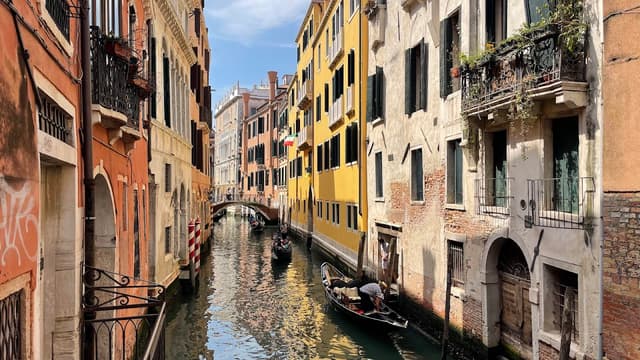
We just crossed the bridge over Rio del Vin. I want to point out that the Venetians had a special way of drinking this drink. This is because there was not much fresh water in the city. It was expensive, but there was a lot of wine, which was cheap to purchase. As a result, they drank wine instead of water. You can taste Venetian wine and visit authentic bakari on a tour of gastronomic Venice.
We're on the Riva degli Schiavoni, Venice's main promenade. The embankment was built on sand and silt that were raised from the Grand Canal's bottom in the 9th century. Schiavoni, a Slavic merchant who delivered meat and fish to many local marinas and piers, gave the town its name. From them also came the name of the sword armed with which the Venetian Doges carried. Their blades were so long, with arms that curved horizontally.
This embankment offers breathtaking views of Andrea Palladio's impressive architectural creations that dominate San Giorgio, the island upon which the most picturesque monastery is located. This island is still relatively undiscovered by tourists.
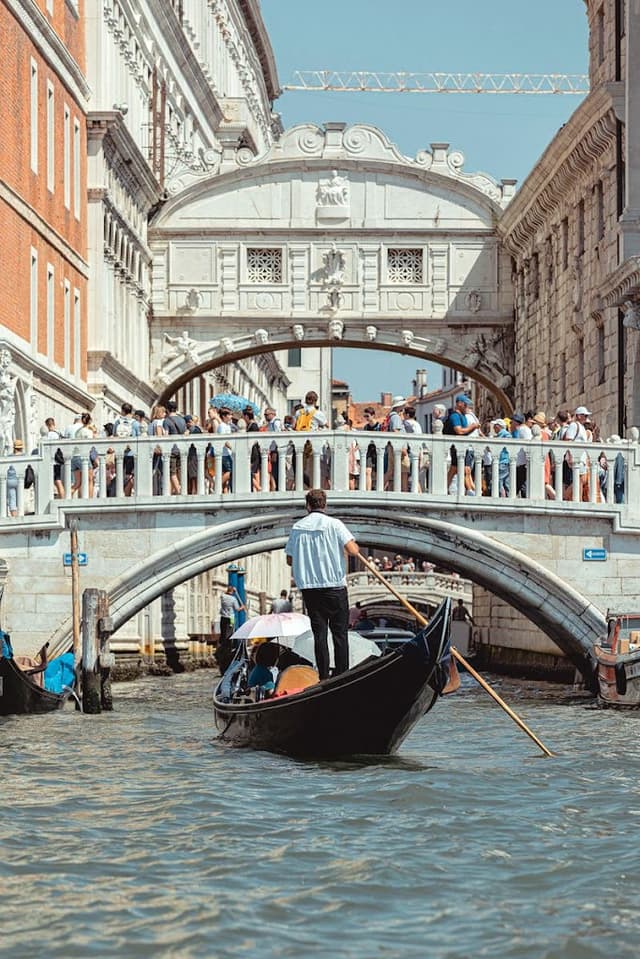
As a compromise, the famous Columbine mask covered only the eyes and was created for the actress who played the role. The actress was so beautiful that she refused to cover her face.Cat masks have also been associated with an interesting story. A Chinese man came to Venice with a cat. He had no money, but a cat. This cat caught all the mice in the palace, which amazed the doge. This cat stayed in Venice, and the Chinese returned home gilded by the Venetian Doge. A few weeks later, he decided that if the Venetians were willing to pay such a high price for a cat, then what would they pay for silk? Said and done. The Doge was thrilled when he saw the silk and promised to pay whatever he could for it... So the old cat returned home.
Come closer to the channel.
The Venetian gondola is another, perhaps the most famous and charming symbol of Venice. A gondola isn't just a transportation vehicle, it's a legend, a fairy tale, magic gliding across its smooth surface. The name "Gondola" appears for the first time in documents dating from 1094a. It is thought that the name derives from the word "gongor" - sea eel. Although the gondola has been around since the 7th century. Making a gondola is a complex, long, and expensive process. It takes a master about three years to make one gondola. The gondola costs between 30,000 and 60,000 euros. Although it appears bulky from the outside, in the hands of a real gondolier, it becomes easily controllable and slides. Gondoliers use only one oar, which is located on the right side of their boat. An iron standard is displayed on the nose of the gondola, which helps you determine whether you can pass under the bridge and how much ducking is required.
Gondolas used to be painted multicoloured and decorated with gold and precious stones. Every rich family wanted to convey their superiority, so they lavished a great deal of decoration and weight on their gondolas. Eventually, the pursuit of luxury transformed the gondolas into floating palaces. The Doge of Venice ordered the gondolas to be painted black, removing all unnecessary decorations. This is how we now know them.Another version says that not only ordinary citizens, but also noblemen visited their mistresses by using gondolas, and that they were responsible for lobbying for the decree to repaint all gondolas neutral black.
It is believed by many scientists that gondolas became black during the plague epidemic, when the dead were transported on gondolas, and the idle decoration was simply not needed.It is worth mentioning that the first gondoliers were slaves, kept by the wealthy families of Venice. With time, Venetians became involved in this business themselves, and the profession developed into a profession overgrown by traditions and passed down from generation to generation. The number of gondoliers in the world is limited, there should always be 425. Getting into this elite club requires passing a lot of tests. The association of gondoliers is official. Unofficially, it's open only to hereditary representatives, Italians, and men.
Despite a decade of struggle, German Alexandra Hae passed the court's approval process in 2007 in order to use the gondola for commercial and personal purposes.When you reach the bridge, stay in the center for a minute and consider the famous "bridge of sighs" immediately after crossing the bridge.

It is believed that a kiss under the Bridge of Sighs on a gondola at sunset will seal the feelings forever. It was built in 1602 by Antonio Contino. A court on the left was the court of the Doge's Palace, and a prison on the right was the prison. However, the origin story of the name has nothing to do with lovers. After the courtroom, the convicts were taken across the bridge to their cell, where they could see the city for the last time before being imprisoned. It is no wonder that sad sighs escaped their chests when they looked at Venice for the last time. In addition, this bridge has a roof and walls because of its uniqueness.
It is one of the most famous landmarks in Venice today. In the 19th century, they did not pay much attention to it because they believed that it did not correspond to the general architecture of the city.Piombi — the "Lead Prison" — can be found to the left of the bridge in the Doge's Palace. The prison gets its name from its location right beneath the lead-plated roof of the palace. The lead plates provided little protection from the cold in winter, but in summer, they were very hot, which made it difficult for prisoners to remain there. The old prison was located on the top floor of the eastern wing of the Doge's Palace, and was intended for political criminals and high-ranking prisoners. The old prison was replaced by the newly constructed prison, Caracheri.
Giacomo Casanova made his famous escape from prison in 1755 and published the story in 1787.
Our next stop will be those St. Mark and St. Theodore columns as we move along the embankment.
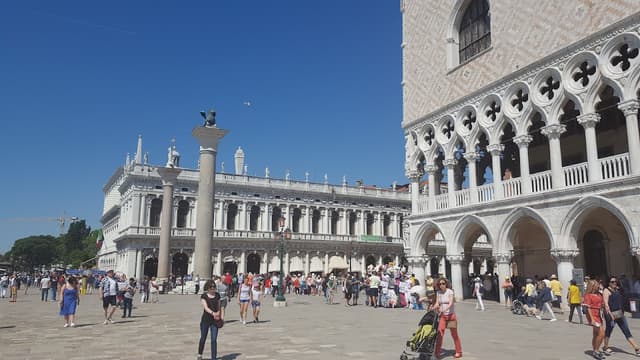
The columns are the water gates of the city. This is our starting point for the most intense part of the tour.It was in the 12th century that these columns were brought to Venice from Syria as trophies. The columns were initially three, but one of them broke when unloaded, and it drowned in the muddy bottom of the lagoon, and was not discovered until now. It took 70 years for the remaining columns to be reinstalled after they were unloaded. It was agreed that architect Baratieri should be allowed to place gambling tables between the two columns as payment for the work.
St. Mark's column is decorated with an image of a lion, which is also Venice's symbol since 862.A crocodile represents the power of Venice on the column of St. Theodore, the city's protector. On the column, he is depicted riding a crocodile.
St. Theodore's Church stood on the site of St. Mark's Basilica until St. Mark was named the city's patron saint.In the past, the bronze lion guarded the Invalides in Paris, at the command of Napoleon I. It was later returned to Venice, but was broken into 84 pieces on the way back. After melting down these pieces, the architect Bartolomeo Ferrari presented a structure consisting of a fragmental mix of metals (brass, lead, bronze), which were connected together through numerous seams and bolts, resulting in a structure. One paw turned out to be a cement-like substance.
There have been public executions here for decades, and locals try not to walk between the columns.Observe the Palace of the Doge on your right, facing away from the columns
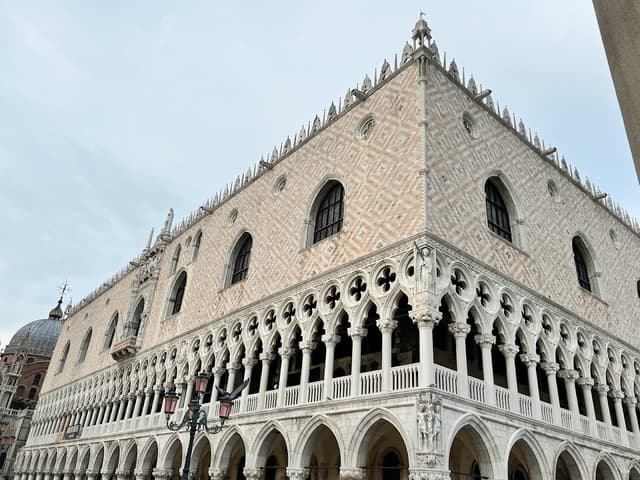
This is the famous Doge's Palace. However, before we get to know it better, let's make a small digression and see who the doges are.It is believed that the Republic of Venice was the largest in Europe when it was founded in 697. The Doge, the leader of the republic, was named after the Latin word "dux", which means "leader". The Doges were initially appointed to serve as Byzantine governors. As soon as Venice became independent, the doges were elected from among the procurators of San Marco. The procurators represent the executive branch. In addition to managing state real estate, they monitor the operation, restoration, and reconstruction of significant structures owned by the government.
There were very few powers available to the doge, as he could not make decisions on his own.He was not permitted to leave the borders of Venice, and he could not own any property outside the state. The doges were chosen from among the most noble Venetian families, so they almost always knew economics and politics, allowing them to rule the republic. The Doge's correspondence, meetings, and contacts were also carefully monitored, which prevented him from having any personal life. There was a time, however, when the doge held almost unlimited power. Until 1032, no state, military matter took place without the intervention of the doge.As a result of the conquest of Dalmatia by Doge Pietro Orseolo II, there was a ceremony known as the "betrothal of the Doge to the Sea." The Doge would stand on the deck of the ship and throw a ring into the sea.
The doge's wife had to be beautiful. This principle guided the Grand Council's choice of the doge's wife. If the doge himself could not take a step without permission, then, as you understand, his wife had no rights at all. She did not influence the course of events. It was Theodora Doukas who broke the rule. She introduced a fork to Venice that changed the culture of food and made a big splash.
As a result, the Doge's Palace is nothing more than the permanent residence of the Doge's Republic. Based on surviving data, it was Filippo Calendario who designed the palace. In addition to meetings held here by the Italian Grand Council and Senate, the Supreme Court was actively engaged in investigations and interrogations by the secret police. The balcony built in the Doge's palace served as a festive tribune from which the Doge addressed his people.
There are many works in the palace created by famous Venetian Renaissance artists such as Veronese and Tintoretto, some of the most famous artists in the world. "Paradise" by Tintoretto can be found in the palace. Since it has a width of 22 metres, and a height of 7 metres, the Venetians consider it to be the world's largest painting. The painting occupies almost the entire wall of the Grand Council with hundreds of figures on its canvas.
A portrait of the doges who sat in the building covers the entire ceiling and perimeter of the building. One of the existing portraits is painted black with a warning inscription. The sign reads, "This is the place where Marino Falier was beheaded for crimes." It is quite an interesting story. Marino Faliera was the active doge at the time, but he was punished for plotting directly against the government. In 1355, he was executed for attempting to establish a monarchy in Venice.
Face the building in front of the Doge's Palace.

The Marcian Library, or St. Mark's Library, or the old reading room, is in front of us. Architect Jacopo Sansovino constructed the structure. Using funeral wreath motifs for facade decoration for the first time, the architect decorated the upper tier of the building with an openwork belt. Scandal is reminiscent of the library's history of creation. Petrarch proposed the construction of a library in the 14th century. Cardinal Bessarion donated 750 manuscripts to the Republic of Venice in the following century, with the condition that they would be made public. His gift is believed to have led to the decision to build a separate library building, which was built in 1537. After seven years of construction, the library's ceiling collapsed. In the aftermath of Sansovino's death in 1580, the architect had to repair the ceiling at his own expense, after being imprisoned for 2 years. Scamozzi completed the building after his death. There are works by Tintoreto, Titian, and other masters in the library halls.
During the 17th century, a law was passed requiring printers to deliver copies of all books produced to the library, which became the Republic of Venice's main library.There is a place behind the library where there are practically no tourists. Although Venice has a few "green corners," there are still some beautiful parks and gardens, which compensate for the lack of diversity with their calm atmosphere and beauty. After a guided tour of the Royal Gardens, you can relax in peace. Founded by Napoleon himself in the 19th century, the Royal Gardens have little remaining of their former splendour today. The garden has numerous benches where you can relax or have a picnic.
As you know, we have been exploring the Piazzetta of St. Mark. To be clear, the Piazzetta is a small territory that extends from the Grand Canal all the way to St. Mark's Cathedral's Campanile. Previously, on the site of the Piazzetta of St. Mark (Piazzetta San Marco), there was a harbor, which was internal to the square of San Marco. In addition to being filled in, the harbor became an atrium. We will visit it next. Go to the Campanilla (the tower).

We are standing next to the tallest building in St. Mark's Square and one of the tallest buildings in Venice. Originally, the Campanile (bell tower) was part of St. Mark's Cathedral. It was built in 890, and was completed in 1517. Over time, it became its own attraction as a place to observe the surrounding area. It served as both a lighthouse and watchtower in the past, as well as a messenger of death, announcing when the next execution would take place.
It completely collapsed in 1902, without hitting a single historical building. The only victim was a cat called the guard's cat that remained underneath the rubble.A large wooden cage was attached to the bell foundation between the end of the 15th century and the middle of the 17th century. In this cage, people were amused and taught lessons.One end of the rope was attached to the dome opposite the Campanile during the famous Venetian carnival to the top of the bell tower (92 metres!) The other end was tied to the palace's dome. It is noteworthy that the death of a prisoner was considered a sign from above. Turkish prisoners were forced to follow such a peculiar "path" as punishment. It meant that if he managed to walk these few metres on a tightrope, then the year would be a success, but if he couldn't, everyone was preparing for a difficult year.Turn left and go to the "Paper Gate", which is located on the left side of the Basilica.

Located at the front of the Doge's Palace, the Paper Gate connects the palace with the Basilica of San Marco. Built in 1442, the gate is one of the last Gothic buildings in Venice. It is quite small in size. Above them is a proud Francesco Foscari (65th Doge), bowing before a lion, with Justice on top.It is believed that this name was given to the illiterate in the area because of the scribes who wrote petitions for them. Local archives, located close to the origin, are another version of the origin. Due to the changes in laws that were posted on the gates themselves, the third version followed.Look down at the sculptural composition. Is it the Four Tetrarchs? It was created in the 4th century from red porphyry and adorns the corner of the Cathedral of San Marco. In order to illustrate the unity of the Roman Empire, the tetrarchs were depicted in pairs: two Augustans embracing one another and two Caesars embracing each other. As part of the Fourth Crusade in 1204, the sculpture was transported from Constantinople to Venice along with other architectural elements that adorned St. Mark's Cathedral. In the cathedral, this part of the building is home to the Treasury.One of the tetrarchs' feet is made of a different material. This item was lost during transportation. A local craftsman recreated the missing parts. A missing foot and pedestal fragment from Istanbul were discovered during excavations in the 1960s, and are now displayed in the Istanbul Archaeological Museum.As we proceed through the heart of Venice, St. Mark's Square, we'll take a few steps toward the main entrance of the famous Basilica of St. Mark.

One of the most popular tourist attractions in Venice is San Marco Cathedral. The Cathedral of San Marco is well known not only for its stunning architecture in the Byzantine style, but also because it is home to the relics of the Apostle Mark. Additionally, the church was constructed in 829 and includes many art objects brought from Constantinople during the Crusades. In only three years, the Cathedral of San Marco was built. Sadly, the original appearance of the building was destroyed during a fire. The modern temple was built in 1063. This cathedral has been the setting for the crowning of kings and queens, the sending of famous sailors on long voyages, and gatherings of city residents during holidays and national disasters. As with any church, the Cathedral of San Marco holds services to this day. It houses one of the most revered Venetian shrines - the golden altar, called Pala D'Oro in Venetian.
The altar is composed of 80 small icons. It took almost 500 years to make.
On the facades of the cathedral are hundreds of sculptures, columns and mosaics, and the eyes are just drawn to them! But if you hold your gaze on the facade and look at it even closer, it is impossible not to be attracted by the mosaic composition "The Last Judgment", as well as the depicted scenes depicting the abduction of St. Mark's body from Alexandria.
There is a connection between the building of the cathedral and the amazing story of St. Mark's relic discovery. During their stay in Alexandria, Venetian merchants Buono and Rustico learned about the construction of mosques on the site of Christian churches. The Alexandrians, who disdained pork, did not examine the contents in detail because they decided to save the relics of Mark and return them to their hometown. They hid Mark's body in a basket under the pig carcasses. After the relics were transported to Venice, St. Mark became the city's patron saint, and the winged lion became the symbol of the city.
Now let's take a look at the cathedral's main entrance.
Overhead, a bronze sculpture of a quadriga (four horses) stands proudly. It was brought to Venice from Greece, then transported to Constantinople in the IV century. It was finally returned to Venice in 1204 due to the efforts of the then doge.
There is more to the cathedral than the main entrance: five carved portals lead to the cathedral. Just look closely - they are decorated with floral ornaments, Gospel scenes, as well as everyday stories from the citizens.Take a look at the cathedral to the left, and we will stop at the clock tower next.

In the late XV century, architect Mauro Coducci built the clock tower, which is simply known as San Marco. After many years, the clock tower has evolved as a result of its own adaptations: a number of restorations have been carried out, individual elements and superstructures have been added to the building, and changes have been made to the clock mechanism.
In the Clock Tower, there are bronze sculptures whose artist is unknown. The flat roof of the Clock Tower features a composition consisting of two Moors striking a bell with hammers, striking the clock, its halves and quarters. The Moors symbolize human time. St. Mark is symbolized by a winged lion under the Moors. It has a small niche under the coat of arms, where a gilded copper Madonna and Child sits. The niche is accessed through doors on both sides. In order to allow the figures of the Magi to "pass" by the Virgin and bow before her and the Savior of all mankind, they are only open a few days a year (on the day of the solemn feast of the Ascension and the week following it).On top of the Clock Tower is a globe, surrounded by a round seagreen dial. On top of time and minutes, the clock on the tower displays the change of seasons, the position of the Sun relative to the zodiac signs, and the phases of the Moon.
It wasn't by chance that the Clock Tower was built in the present location. Venetian wealth and power were supposed to be demonstrated to all visitors from the coasts of the Adriatic Sea, and the clock would be visible from here. In the XV century, this was a true miracle since even the largest cities couldn't get a similar clockwork.
We will now move to the middle of San Marco Square.
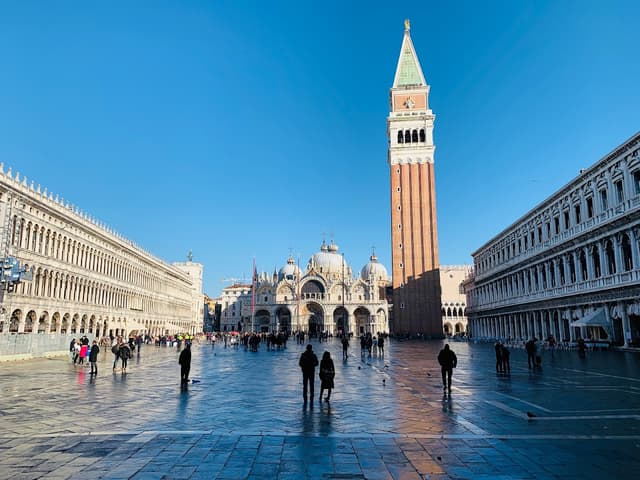
As Napoleon carelessly threw this phrase at the time, many Venice guides now say: "This square is the most elegant living room in Europe." We are talking about San Marco Square, the very centre of which we are situated. In reality, it is a secular salon, lit at dusk by electric lamps along its perimeter. There is a violin playing from the side of the old cafe. Bonaparte's words are true, and there is a magical atmosphere in the air.
San Marco Square is the lowest point in Venice. When floods arrive, the square turns into a shallow lake. To drink coffee, residents of Venice and tourists need to wear rubber boots and walk on wooden floors.
It is the only St. Mark's Square in the city that the Venetians themselves call a square. The rest are called camps or campiellos by residents - fields or small fields.There are no other places in Venice where feeding pigeons is permitted. You will be fined if you do it. In addition to masks and gondolas, pigeons are a symbol of Venice. More than seven hundred years ago, pigeons rendered immeasurable assistance to Venice.
A number of amounts were allocated annually in the state budget for the purpose of feeding pigeons in old Venice. The abduction of pigeons was punished cruelly, up to the death penalty.

There are two buildings on either side of the square that are likely to capture your attention: the Old and New Procuratories - the places where the "fathers" of Venice sat and lived.
A vivid example of the early Renaissance, the old Prosecutor's Offices in Venice were constructed between the XV and XVI centuries. Under the open-work arches of the old Prosecutor's Offices, a number of shops were set up. In addition, one of the premises was occupied by the legendary coffee shop "Quadri" - which remains in operation to this day.As soon as the building of the Old Prosecutor's Offices became owned by a private individual, the decision was made to construct a new building. During the construction of the New Prosecutor's Offices in 1582, the Library of St. Mark was located on the lower level. The New Procuratorium housed nine procurators who maintained the cathedral's treasury and controlled the cathedral's expenses. In Napoleon's time, the New Prosecutor's Offices became the Royal Palace. At the same time, a two-tiered annex was added to them called the Napoleon Wing. Under Napoleon, lavish receptions and balls were held in the Napoleon Wing.
Take a closer look at "Florian" cafe.

There are countless ways to brew coffee in Italy, so Italians know more than anyone else in the world that it is not just a drink... It is a ritual, a mood, and a lifestyle. Since the first mention of coffee beans in Europe was made in Venice in 1720, it is no wonder that the main Mecca for coffee lovers – Cafe Florian – is located here. Florian is the oldest cafe in Europe. They know how to make coffee according to 33 different recipes. There were times when Casanova, Byron, Hemingway and others liked coming here for a cup of fragrant drink. The prices here are of course astronomical. Of course, nearly every famous star of the stage and screen considers it their duty to sit in the "Floriana" during their stay in Venice. You can get our gastronomic tour of Venice if you want to know the addresses of cafes and bars locals go to.
Leaving San Marco Square, we will follow the signs toward the Rialto Bridge. When we get there, do not rush; instead, make a stop at the canal.

Known as Canalazzo by the Venetians, the Grand Canal is the city's main transport artery. The Canal, in the shape of an inverted Latin letter S, is the main road. A 45-minute vaporetto ride is the most convenient way to explore the Grand Canal and its palaces. An example of a public transport vehicle is the river tram. Another type is a tragetto. Ferries are gondolas that can carry 15 people standing. Throughout history, there have been palaces along the Grand Canal that symbolize the power and prosperity of Venice, making it impossible to walk along the canal. During the Renaissance, every wealthy family thought it was their duty to build a palace along the Grand Canal. We have a kind of open museum on the water, with Vendramin Calergi being considered one of the most famous palaces. Not only did they build, but they also outshined their neighbours' luxury. The "Casino di Venezia'' has been there since 1959, and in 1995, the Wagner Museum, dedicated to the composer who died there of a heart attack, opened.
There are four bridges across the Grand Canal, including the Rialto Bridge. Climb up and marvel at the view.
At the narrowest point of the Grand Canal, the Rialto bridge is the oldest. The history of this pontoon bridge dates back to 1181, when it was known as the Ponte della Moneta. According to legend, the bridge appeared because of the nearby mint. In 1255, a new wooden bridge appeared on the site that allowed ships to sail freely with two inclined ramps. The bridge gained its present name – Rialto, the name of the local market – at the same time. As a result, medieval wood structures (especially bridges) needed lots of money to maintain. Therefore, the shops built on the bridge in two rows came in handy: their owners paid taxes to the state treasury. The wooden version of the bridge came to an end in 1444. In the event of a parade, the Ponte di Rialto simply could not handle the crowds. The result was a sad collapse. A stone bridge was constructed in 1588 and completed in 1591.
To get to Rialto market, cross the bridge to the end.
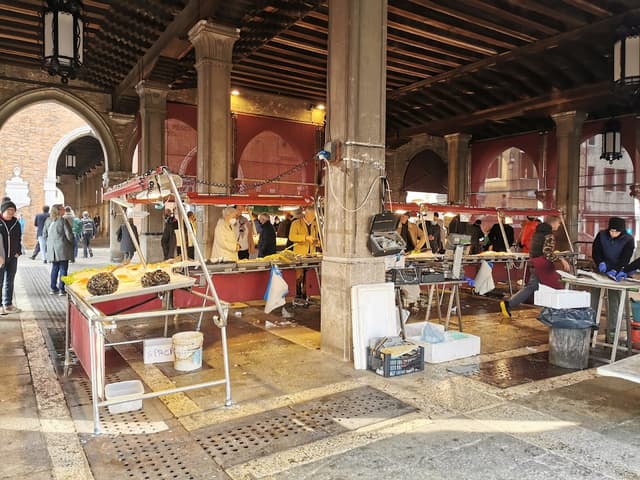
The Venetian market is located on the right side of the Grand Canal, near the Rialto Bridge. Natural goods have been sold here for many years. Buy vegetables, fruits, and other provisions in the old and new malls. The Fish Market offers fresh seafood Tuesday through Saturday in its slender neo-Gothic pavilion.
If you visit the market later, there will not be a large selection of products, but there is a chance to get significant discounts. Come early in the morning for fresh berries and dates, sit on the sidewalk and watch how Venice wakes up.Those who wish to immerse themselves in the atmosphere of the country must visit the restaurants and cafes on the market. In this place, you can feel the spirit of Venice, not tourists from different continents, because the authentic Italian atmosphere has been preserved. You can observe how Italians live at the Rialto market, where the Venetians themselves shop.When it comes to grocery shopping, Rialto offers the most convenient combination of price and quality.
The home for unique & authentic travel